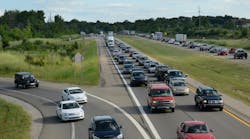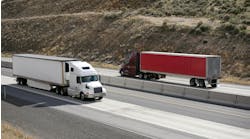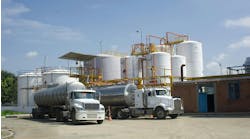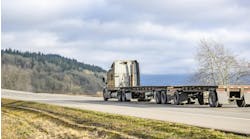Unraveling the gridlock: How traffic congestion stifles urban growth and quality of life
In the bustling arteries of our modern urban areas, traffic congestion continues to suffocate growth and progress while stifling quality of life. What was once an occasional inconvenience has become a chronic affliction, strangling economic growth, amplifying pollution, and testing the patience of fleet operators, commuters, business owners, and residents alike. The challenges posed by congestion are multifaceted, presenting a complex puzzle that demands innovative solutions.
The growing grip of congestion
Traffic congestion has evolved from a localized issue to a systemic barrier to growth. In major urban centers around the world, it's not uncommon for fleets to spend hours navigating clogged roads, inching forward amidst a sea of brake lights. This congestion isn't just frustrating; it's also expensive. Studies show that congestion costs billions annually in lost productivity, wasted fuel, and increased transportation costs.
According to industry observers, traffic congestion and the associated delays cost the U.S. economy over $120 billion annually. Another study showed that in 2022, U.S. traffic congestion resulted in the average driver spending 51 hours in traffic, equating to approximately $869 in lost time and increased pollution.
Stifling urban prosperity
Congestion poses a direct threat to economic vitality. Local businesses struggle with delayed deliveries and increased transportation expenses, leading to higher prices for consumers. Moreover, the allure of urban centers as hubs of innovation and commerce diminishes when the promise of accessible mobility is overshadowed by endless traffic snarls. Investors and entrepreneurs think twice about establishing roots in cities where gridlock reigns supreme.
Quality of life under siege
The impact of congestion extends beyond economic realms, seeping into the fabric of everyday life. Drivers face heightened stress levels due to longer commutes and unpredictable travel times. Air quality deteriorates as engines idle in perpetual traffic, exacerbating respiratory issues and environmental concerns. Pedestrians and cyclists, essential components of vibrant urban landscapes, are sidelined by congested roads that prioritize cars over alternative modes of transport.
Innovative solutions being implemented in select cities
Traffic congestion is not unlike congestion that builds up in the human body. When we see a doctor, we are prescribed a treatment that clears the congestion. Similarly for roads, rather than setting up road signs and cones to redirect traffic, cities must take a more prescribed treatment approach through technology such as transit signal prioritization. This innovative technology leverages cloud-based and AI-powered real-time data and smart algorithms to optimize traffic flow, giving priority to public transport vehicles such as buses, emergency first responders, and snowplows in northern climates. By reducing delays at intersections, transit signal prioritization accelerates the efficiency and attractiveness of local commuters.
See also: Gaskins: Traffic congestion and highway funding
Benefits beyond the bus lane
The advantages of transit signal prioritization extend far beyond public transit users. By improving the reliability and speed of buses, this technology incentivizes commuters to choose sustainable transport options over private vehicles. This shift alleviates overall congestion for local truck fleets and deliveries, freeing up road capacity and reducing emissions. In essence, transit signal prioritization is a catalyst for a more balanced, efficient urban mobility ecosystem.
To combat the scourge of congestion and unlock urban potential, cities must prioritize innovation in transportation management. Embracing platforms like transit signal prioritization represents just one piece of a larger puzzle. Integrated approaches that blend public transit enhancements with policies promoting shared mobility, cycling infrastructure, and urban planning reforms are essential.
Key to the success of this platform is the integration of traffic signals and intersections with the flow of traffic, which of course changes based on events, work hour vehicle demand, weather patterns (evacuations, etc.), and the prioritization of emergency response vehicles that need to move freely through certain corridors to get to an injured person or fire, for example. Much of this is already in use in several cities across the U.S., all driven by AI.
How AI improves the flow of traffic for everyone
AI promises to streamline traffic flow and reduce congestion for many of today’s busiest roadways and thoroughfares. Smart traffic light systems and the cloud technology platforms they operate on are now designed to manage and predict traffic more efficiently, which can save a lot of money and create more efficiencies not only for the cities themselves but for individuals also. AI and machine learning today can process highly complex data and traffic trends and suggest optimum routing for drivers in real time based on specific traffic conditions. By integrating everyone’s real-time routing information, cloud-based traffic management systems can now optimize traffic light timing to the true needs of traffic. Additionally, since there is no need for expensive hardware additions or buildouts, city budgets are not expected to expand.
Today’s recognition algorithms offer enhanced insight on the mix of density, traffic, and overall rate of flow. Furthermore, these optimized algorithms can leverage data points by region resulting in a streamlined pattern to reduce traffic problems while redistributing flow more optimally. Municipal traffic management systems can then make better decision-making power, and the control system has a much higher degree of failure tolerance as was previously demonstrated in legacy hub-and-spoke systems.
Traffic congestion represents a formidable challenge for cities worldwide, imperiling economic growth and eroding quality of life. However, this challenge is not insurmountable. By embracing innovative solutions like transit signal prioritization and fostering holistic approaches to mobility management, cities can break free from the grip of gridlock. The road to congestion-free cities is paved with innovation, collaboration, and a collective commitment to reclaiming our streets for the prosperity and well-being of all. Let us seize this opportunity to redefine urban mobility and revitalize our cities for generations to come.




